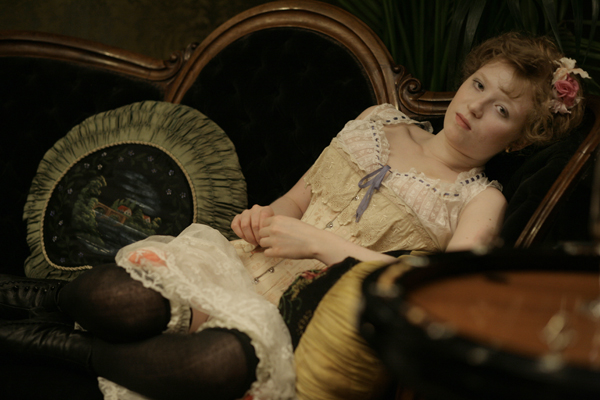
A scene from the bordello, HOUSE OF PLEASURES (Sundance Selects)
Written & Directed by Bertrand Bonello
Produced by Bonello & Kristina Larsen
Released by Sundance Selects
French with English subtitles
France. 125 min. Not rated
With Hafsia Herzi, Céline Sallette, Jasmine Trinca, Adèle Haenel, Noémie Lvovsky, Alice Barnole & Iliana Zabeth
Set in a brothel at the turn of the 20th century Paris, this methodical if overly heady period drama may depict the most elaborate and decadent of sexual vices, but director Bertrand Bonello spares us none of the horrible details by which they are procured. Viewers might be rapt at the varied array of solicitations if it weren’t for the fact that Bonello’s camera remains in the room after the John is gone, capturing the painful fallout.
This is a film that, without too much show, captures the essential opulence of the Belle Époque period: the deflowering of a virgin in a bath of champagne and the taking of two women of different ethnicities to bed at once while a pet panther reclines in the downstairs drawing room. The sex scenes themselves are part poetic and part historical record—meticulously composed, with a lot of skin, while also giving the impression of factualism. As the sex continues each night, the madam of the house falls victim to blackmail, one girl is dead of syphilis, another addicted to opium, and a third is brutally mutilated by a sadistic patron. “It stings,” the older women warns the new hires regarding the mouthwash and cologne they use on their genitals between sessions. “But that’s normal.” It’s not only these tragedies but the daily pain of a prostitute’s life that gradually make themselves apparent.
This is really a slow moving think piece, despite all the action. A journalist somewhere in Bonello compels him to offer us the minutiae of life during the industrial revolution. You’ll find yourself wondering what it was like to be a prostitute during the time, and second, what it was like to be anyone more than a century ago. Apart from a few effective directorial flourishes that remind us of some universalities, through soulful R&B tracks or the 1970’s-style split screen, this velvety, earth-toned historical period is rendered well. (Where they smoked opium then, today they swallow pills.) Bonello’s favorite blues artists—Lee Moses and the Mighty Hannibal, to name two—raucously lament their woes to the audience.
Populating the drawing room and playing the Johns (or is it Jeans?) are several French filmmakers, which include Xavier Beauvois (Of Gods and Men) and Jacques Nolot (Before I Forget). It’s a funny little in-joke on this director’s part, yet he’s in a way pointing the finger back at the filmmaker-as-artist who might perpetrate a similar abuse. No director asks his or her actors to simply “play the part.” Not to say that any of these specific filmmakers are guilty of exploitation, but as I’m starting to be aware of this year’s crop of award-baiting and soul-baring dramas (see Melancholia; Martha Marcy May Marlene), maybe I see his point.
The closing shot, with “Bad Girl” by Lee Moses playing over it, hits a lot harder than I expected. It kind of makes the whole movie. Shot on video, Bonello shows us a modern-day hooker near a highway overpass looking for the next score amid a small group of others. And there’s Moses telling us that’s just the way it is. If you didn’t get the idea already, there it is. It’s followed by a special dedication to a list of women, and it is heartbreaking.






Leave A Comment